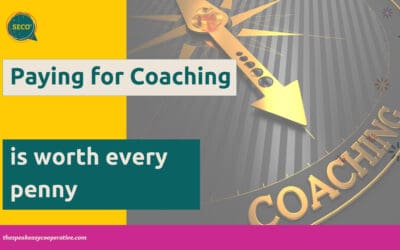I cannot implore you enough: please, please please, please stop selling your time. Time is merely the tool we use to deliver what we do sell – which is so much more than our time. How we move from this paradigm can be handled in many ways. I’d like us to look at one way called value-based pricing. What I aim to do in this article is begin to introduce what value-based pricing in the arts looks like, specifically vocal coaching and voice teaching.
Because I’ve been offering a value-based model for about ten years, I’ve had the joy and consternation of developing and redeveloping this model, mostly because that’s the entire point: To understand so clearly what value, results, and growth we can provide for the client in front of us, that we can lay that out and charge appropriately for those things – rather than merely charging for our hours at the keyboard, canvas, microphone, or piano.
What is Value-Based Pricing?
I like the way Investopedia tends to make things plain. They say, “Value-based pricing is a strategy of setting prices primarily based on a consumer’s perceived value of a product or service. Value pricing is customer-focused pricing, meaning companies base their pricing on how much the customer believes a product is worth.
Value-based pricing is different than “cost-plus” pricing, which factors the costs of production into the pricing calculation. Companies that offer unique or highly valuable features or services are better positioned to take advantage of the value pricing model than companies which chiefly sell commoditized items.”
In short, value-based pricing is focused on enhancing the experience, joy, lifestyle, dreams, and hopes of a client. It’s client-centered, allows for extravagant service and opportunity, and truly feels like an “above and beyond” experience!
This is why I believe that value-based pricing is a wonderful fit for the voice professional – we are generally the type of humans who want to go above and beyond from the get-go. We want every client and student to feel unique, seen, special, and taken care of. Yet, we resent actually providing these things because we fall for the myth that people by 30, 45, and 60-minute chunks of our time, in order to learn some music-y thing, and that we are expected to deliver whatever-it-is we do in this weekly model. (If you’re curious to hear a little of my own aha moments with this, you can hear me speak of it on Tara McMullin’s What Works podcast, here.)
Value-Based pricing put the spotlight on the client, while meeting the needs of the business owner. I find, for voice people, it works best when a boutique model is employed, so that there is plenty of time available to meet the needs of the client.
Who is this model right for?
This pricing model is not right for every business owner, and it’s not right for every client.
You may be a good fit to offer value-based pricing if you or your company:
- Have a clear understanding of what you do inside and outside of the time you spend face to face with each client and how that enhances the student/client experience.
- Understand the individual needs of each potential client that comes to you via a solid onboarding process so you can create a detailed and accurate scope of service.
- Are willing to take the time and energy to do a massive think through of your network, resources, special mojo, unique skill sets, and unique ways you engage your clients (and their families!) holistically.
- Are willing to take the time and energy to develop customized offers for each client that comes your way.
- Are able to provide enough flexibility that the goals and results of the student become more important than the time you spend with them.
- Have a strong brand connected to the deliverability of results.
- Are ready to never use the word “time” again in your marketing or productizing of your service.
- Are ready to address pricing and fee structures from a holistic transformational perspective rather than a transactional perspective.
- Want to make more money with fewer clients – and those clients are the perfect fit
You may be a good fit as a client of a person with this model it you or your family:
- Prefer to be an active part of the development of your skills
- Have a clear desired outcome, or are willing to work with your teacher to develop one.
- Aren’t worried about “getting the time owed to me” – rather – you’re more interested in achieving desired results in the most effective way possible.
- No longer see box-checking of task to be equivalent to success indicators, or are willing to try that out.
- Desire to have a more robust relationship with your voice coach or teacher (or other type of service provider) that requires open communication and clarity.
- Desire to have a network of people available to you via the hub of your teacher/coach.
- Are ready to let go of the idea that “weekly lessons = product” or “weekly lessons = what I pay for.” (It isn’t anyway, by the way)
How to start going about value-based pricing:
- Read Breaking the Time Barrier by Mike McDerment. It’s a free PDF of a book that will flesh out the concepts even more.
- Fill out the “What’s In Your Hour?” Worksheet, that can be found here. This is a start and a way to get your brains moving on everything that goes into your business’ unique value proposition.
- Use the SAME downloadable, or another sheet of paper, and now use it to write down everything you bring to the table when it comes to your expertise, network, unique skills, personality, core values, and mission.
- Come up with your master package – use these prompts: You have one client. They are your perfect fit. What do you provide them, why, and how? How are they different after working with you? Who are they after working with you that they were not before working with you? What do you know about them and how can you communicate that you “get” them?
- Schedule a session with me to start really fleshing it out, or wait a bit until I have the follow up blog written, or, if you’re in SECO, you can watch the training on it in the member’s area. Remember – this is HIGHLY personal and individual, so there’s no such thing as a “template” for the right kind of package. We can develop a template around how you communicate YOUR version of these packages.
As you get started, avoid these common pitfalls:
- Do not think about numbers or pricing while you are creating your grand plans. If you start with “How much money do I think I can make on this?” or get into some weird “no one would ever pay me $XXXX”, then you’re gonna just hold yourself back and create smallness. Use your creative mind – let it flow!
- Try not to assume your current clients do or do not want or need what you are providing – much of the time, your clients actually want to work with you, and will just buy what you tell them to buy. If you are selling your time, that is what they will buy. You may have people that if you sold results, they’d have the aha that this is what they are investing in all along.
- Don’t forget the things that YOU find plain, or easy, or fun, are the things that other people are craving to experience and need your help realizing. Do not diminish the value to others because something isn’t valuable to you.
- On the flip side, honor what IS valuable to you – if you crave consistency, add that in. If you crave freedom and flexibility, go that way. What does your ideal client want and need? Does it line up with what you can and will provide?
- This is the hardest one: DO NOT INCLUDE WITH THE NUMBER OF LESSONS or the LENGTH OF LESSONS ANYWHERE. I dare you to come up with a plan that doesn’t give one hoot about time.
- Be mindful to not fall into the “BuT HoW Do I pRicE iT tHen?” trap. We will get there later.
Finally, unlearn your idea of time and money.
Relearn to embrace results. Think of it this way: You go to a coffee house to order a yummy latte. The latte is $7.50. (Hey it has organic soy and an add shot, and we are at a boutique establishment).
There are two baristas working – a seasoned pro and a new learner.
If the seasoned pro makes your latte in 2 minutes, should they get paid less because they spent less time on your latte? After all, they were able to get you your desired outcome quickly (and with a fancy design!) because of their expertise.
If the new learner makes your latte in 15 minutes, should they get more money from you because it took them more time? After all, it’s not your responsibility to pay for their training, is it?
You are paying for the value of that latte to you – not the time it took to make it. You want the latte. You don’t want the barista to be punished for being effective and efficient, and you don’t want to be punished because your latte maker is still learning the ropes.
In the same way – You should not be financially punished for getting a voice user results in a shorter amount of time than it would take another teacher. Your client should not be financially punished by having to pay you for more time if you are the one who needs to gather the tools to get them the results they paid for.
More directly: If you can provide a student a stellar audition package and a feeling of confidence and readiness for their big audition, it doesn’t matter if that comes in five lessons or in fifteen. The client isn’t paying for your time – they are paying for the stellar audition package and the feeling of confidence and readiness. The value is the same.
Why should you get paid less if you are able to provide that in five lessons, and why should you get paid more if you need fifteen? The only answer to this is “well, my time.” and that’s the point.
Value-based pricing for the arts is about you know yourself and your client well enough to know what you can deliver on and how, and you’re willing to do what it takes to make it happen.
That’s what the scope of service is for – to lay out the deliverables, the rules around engagement, and the game plan.
Want a little more info?
Watch my “Value Based Pricing and How does it help Voice peeps” video recorded Live on Facebook. I fleshed this out a little more and teased our Tuesday Training for The SpeakEasy Cooperative on just this thing.
All My BeastyBoss™ (™ even!),







0 Comments